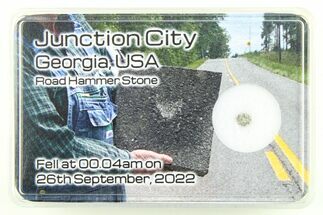This Specimen has been sold.
.09" Martian Nakhlite Meteorite Fragment - NWA 15200
This is a .09" wide martian meteorite fragment from a recent find in Algeria known as NWA 15200. It comes in its own labeled acrylic case.
NWA 15200 is the name given to a nakhlite Martian meteorite found in Algeria in 2022. The total known mass is only 196 grams. Fragments typically have a beautiful dark fusion crust with some evidence of regmaglypts surrounding green, cream, and orange-brown interior clasts. Larger fragments can be rather crumbly. Like other nakhlites, it is volcanic in origin and rich in augite and olivine.
About Nakhilite Martian Meteorites
Martian meteorites are rocks that formed on Mars before being ejected by asteroid impacts, traveling through space and landing on Earth as a meteorite. As you might expect, Martian meteorites are quite rare, representing less than 0.5% of all classified meteorites. The combined weight of all known Martian meteorites is only several hundred kilograms.
Superficially, Martian meteorites look very similar to igneous rocks on Earth. Mix a Martian meteorite into a pile of igneous rocks found on Earth, and you may not find that meteorite again! Thus, nearly all Martian meteorites that have been identified were found in regions naturally devoid of rocks, like sandy deserts (Sahara Desert and Omen) and the Antarctic ice sheets. These meteorites are interpreted as Martian in origin because these have elemental and isotopic compositions similar to rocks and atmospheric gasses on Mars.
Nakhlites are an incredibly rare form of Martian meteorite named for the first of their kind, which fell near the village of El Nakhla in Egypt in 1911. They are igneous rocks rich in augite and olivine, formed from basaltic magma on the surface of Mars about 1.3 billion years ago.
Scientists have traced nakhlites' potential source to a 6.5-kilometer crater in a volcanic field northwest of Elysium Mons, though they could also be sourced from the Tharsis or Syrtis Major Planum volcanic constructs. Nakhlites were suffused with water about 620 million year ago, and were ejected from Mars about 11 million years ago by asteroid impact. All the known nakhlites on Earth have fallen here within the last 10,000 years.
Martian meteorites are rocks that formed on Mars before being ejected by asteroid impacts, traveling through space and landing on Earth as a meteorite. As you might expect, Martian meteorites are quite rare, representing less than 0.5% of all classified meteorites. The combined weight of all known Martian meteorites is only several hundred kilograms.
Superficially, Martian meteorites look very similar to igneous rocks on Earth. Mix a Martian meteorite into a pile of igneous rocks found on Earth, and you may not find that meteorite again! Thus, nearly all Martian meteorites that have been identified were found in regions naturally devoid of rocks, like sandy deserts (Sahara Desert and Omen) and the Antarctic ice sheets. These meteorites are interpreted as Martian in origin because these have elemental and isotopic compositions similar to rocks and atmospheric gasses on Mars.
Nakhlites are an incredibly rare form of Martian meteorite named for the first of their kind, which fell near the village of El Nakhla in Egypt in 1911. They are igneous rocks rich in augite and olivine, formed from basaltic magma on the surface of Mars about 1.3 billion years ago.
Scientists have traced nakhlites' potential source to a 6.5-kilometer crater in a volcanic field northwest of Elysium Mons, though they could also be sourced from the Tharsis or Syrtis Major Planum volcanic constructs. Nakhlites were suffused with water about 620 million year ago, and were ejected from Mars about 11 million years ago by asteroid impact. All the known nakhlites on Earth have fallen here within the last 10,000 years.
TYPE
Martian (Nakhlite)
AGE
LOCATION
Algeria
SIZE
.09" wide
CATEGORY
SUB CATEGORY
ITEM
#285782
 Reviews
Reviews












